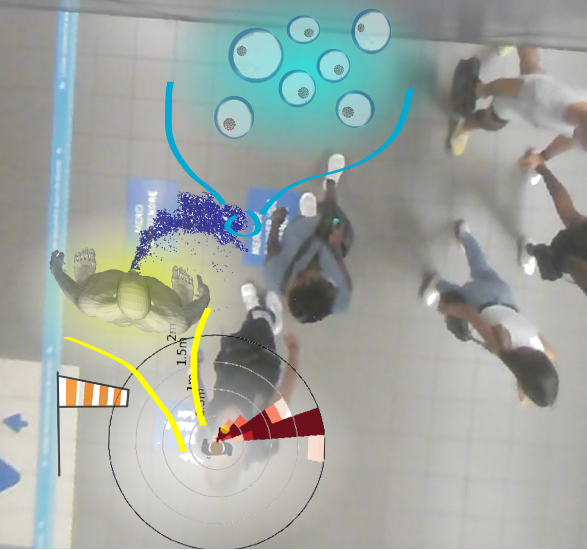Viral Transmission in Crowds: Bridging the Gap from Microscopic Simulations to Practical Cases
Researchers from the CNRS-affiliated Alexander Grothendieck Institute in Montpellier and the Lumière Matière Institute have showcased a particularly effective method to transition from time-consuming microscopic fluid dynamics simulations to macroscopic studies of airborne viral transmission in crowds. This breakthrough paves the way for accessible risk assessments of direct exposure contagion across a wide array of realistic scenarios. Their findings have been published in the Advanced Science journal.
In the early stages of the COVID-19 pandemic, numerous studies emerged, some of which were based on questionable assumptions due to the use of overly simplistic viral transmission models. On the other end of the spectrum, highly detailed models using the Navier-Stokes equations, which govern fluid motion, sophisticatedly simulate the propagation of respiratory fluid droplets through the air. While these models offer a greater degree of realism, they face challenges in data analysis due to the complexity of the produced data (what to do with these thousands of finely resolved trajectories, changing with every micro-movement?) and, more significantly, their prohibitive computational time, with each run potentially requiring days of computation on supercomputers.
A "Risk Map" with Limited Efficacy
To optimally leverage both types of approaches, one idea is to utilize finely resolved microscopic fluid dynamics simulations and infer a dynamic risk map around a transmitter, locally quantifying the probability of the presence of infectious aerosols. However, a single map is far from sufficient, as the "risk map" obtained varies depending on whether the person is talking or not, walking or stationary, affected by wind or air currents, etc. Therefore, it becomes necessary to compile a library of reference situations and interpolate the results from these reference cases for un-simulated parameter values.
This is precisely what the researchers have committed to, and the rewards for their efforts extend beyond the technical intricacies of the method. Specifically, even a slight breeze dramatically reduces the risks of viral transmission. This finding conclusively addresses a debate that began early in the pandemic, where there was uncertainty about whether wind aids contamination by carrying droplets and aerosols further, or conversely, inhibits it by dispersing them. In outdoor situations with significant risks, it is the latter effect that prevails.
The Significant Role of Density and Expiratory Activities
More broadly, the substantial reduction in computational cost achieved through transitioning to "dynamic risk maps" has enabled the study of practical scenarios involving hundreds of people. To accomplish this, researchers walked the streets of Lyon during the pandemic, filming people from above to maintain anonymity, in various frequented locations of the metropolis, both outdoors and in minimally confined indoor settings (spacious and well-ventilated). These locations included an SNCF train station, a metro station, busy streets, an open-air market, café terraces, and a landscaped bank of the Rhône River. From these videos, the trajectories and orientations of pedestrians' heads were extracted; these data were then coupled with precalculated risk maps. The analysis concluded that the busy streets (which were not crowded during the observed period) presented a very low risk compared to the much denser open-air market. As expected, density plays a major role. Nevertheless, all these situations involving passing crowds presented less risk of new infections than café terraces, where people share close and prolonged contact, even though the overall density is lower. Finally, expiratory activity plays a major role, as the emissions of respiratory droplets from a person talking are significantly higher than from a person breathing through their mouth (and even more so through their nose).
This prioritization of practical scenarios based on theoretical-numerical models illustrates how modeling can leverage high-fidelity simulations to examine everyday situations and serve as a decision-making aid in public health. The modeling tool thus acts as a valuable bridge between fundamental knowledge of airborne viral transmission and the implementation of health measures.
This collaboration was initiated through the working group of the MODCOV19 platform of the INSMI.

© Baptiste FRAY, Willy GARCIA, Simon MENDEZ, Alexandre NICOLAS / CNRS
Contact
Laboratoires
- Institut Montpelliérain Alexander Grothendieck (UMR 5149, CNRS et Université de Montpellier)
- Institut Lumière Matière (UMR 5306, CNRS et Université Claude Bernard Lyon 1)
